"I did not come to talk," said Maxwell. "I came to sit with you."
"Sit then," the Banshee said. "It will not be for long."
The prep
Space Shuttle is the largest flying rocket, being at least twice heavier than anything else that takes off from Earth and reaches space.
I wanted to see the launch of it since 1990. I had all means to do so since 2000. In 2010 I finally made the trip.
It was not the last opportunity by any standard, but certainly a stretched one. There were only three Shuttle flights remaining, and the number of people wishing to see it exceeded the number of tickets available by a factor of ten or so. There is no surprise then that all tickets were "sold out" at the NASA's site in about 40 seconds and then appeared on eBay tenfold more expensive then the original NASA's offer. What happened was clear to me. But was it clear to NASA who apparently believed that it is possible to maintain an island of socialism surrounded by a free market and not cause an insane speculation around the fixed price? I don't know. In any case, I ended up using eBay.
So on the morning of May the 14th, 2010, after spending the night in Orlando, FL, I arrived to NASA Kennedy Space Center Visitor Complex.
I was greeted by tired security personnel, 90+ degrees weather and 0.6 miles long line for buses boarding for NASA's launch viewing site:
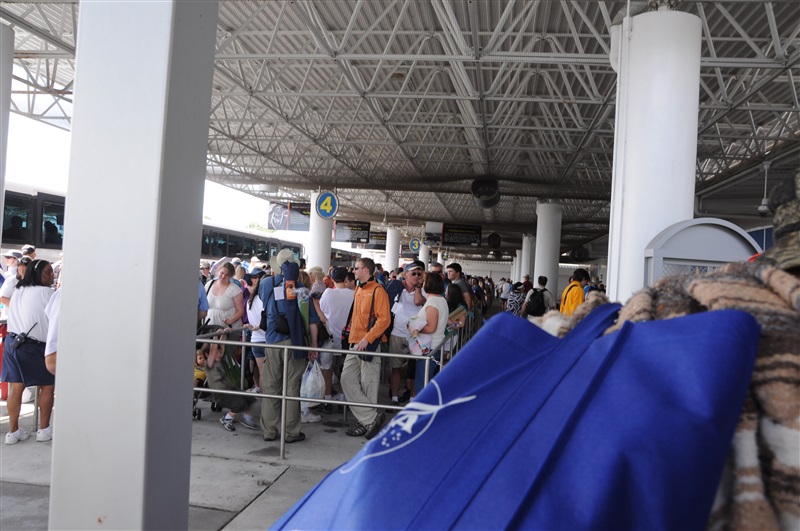
After only 50 minutes spent in that line and some 15 minutes of riding the bus I arrived to NASA Causeway Viewing Site and discovered that the crowd there was even bigger. No surprise:) I'd say about 10 thousand people have gathered there:

...all stretched between two yellow stripes separating the land of crocodiles on one side, and the road on the other:
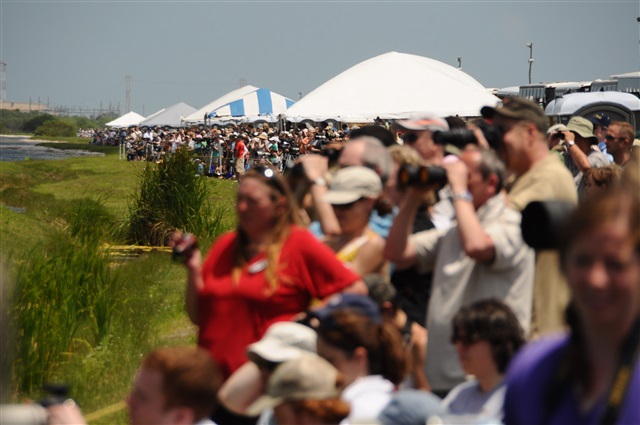
The Space Shuttle, 6.6 miles away, was barely visible and not impressive at all to the naked eye:
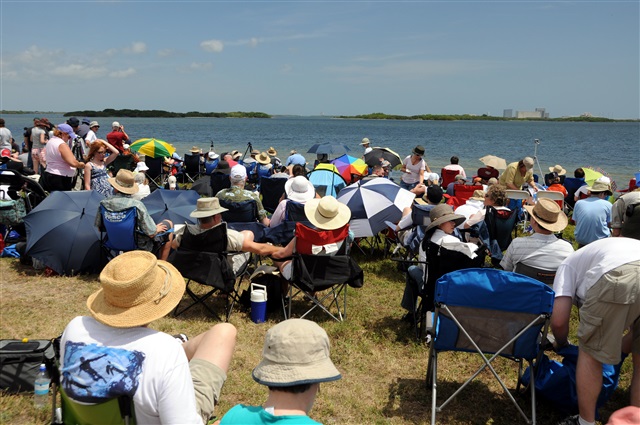
But for a photographer, anything is a unique opportunity for a new picture :)
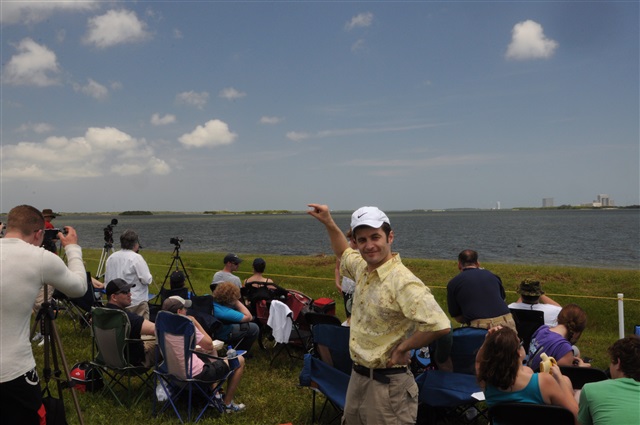
Applying full power of 200 mm lens and the right combination of optical filters led to a better result:
The image above is taken through the 650 nm red optical filter and polarizer set to the maximum air transparency. The effective focal length there [after cropping] is 685 mm. The actual resolution is about 16 inches after accounting for diffraction and atmospheric scattering.
It was 92 degrees out there. Thousands of people were roaming along this strip of land, eating something, drinking, and fine-tuning their cameras:
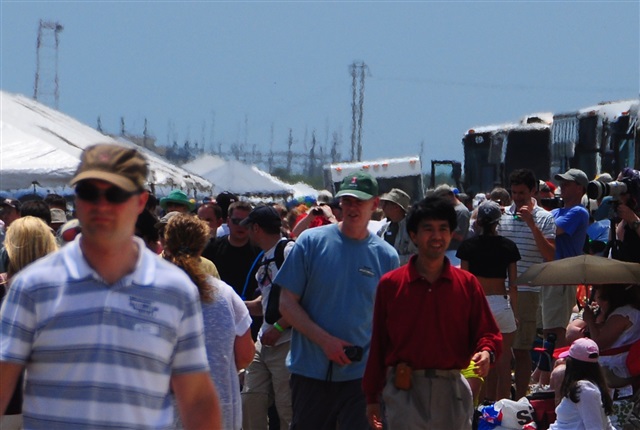
The countdown was suspended twice, at T-20 and at T-9 minutes. Both were scheduled, actually, but I did not know that and the loudspeaker's sound was so poor that many of us could not make much of it. So the tension was growing and peaked at the Go-No go poll a few minutes before the liftoff. It sounded almost like a ritual, like some magical cantation:
-- LPS?
-- LPS is go.
-- Houston Flight?
-- Houston Flight is go.
-- MILA?
-- MILA is go.
-- STM?
-- STM is go.
-- Safety Console?
-- Safety Console is go.
-- SPE?
-- SPE is go.
-- LRD?
-- LRD is go.
-- SRO?
-- SRO is go, range is clear to launch.
-- And CDR?
-- (pause) Atlantis is go.
At that moment, I nearly felt the tension of thousands of people, computers, devices all lined up and readied to support the flight. And the responsibility that stood behind each terse "go".
Enough to give me creeps :) The price of error in my industry typically is not that high.
And finally, there was the liftoff.
The Launch (it's a slide show; click on the picture to see the next one; using F11 is recommended)
|
|
Loading...
=========================================================================================
This is it. In three minutes there is nothing but a smoky trail in the air:
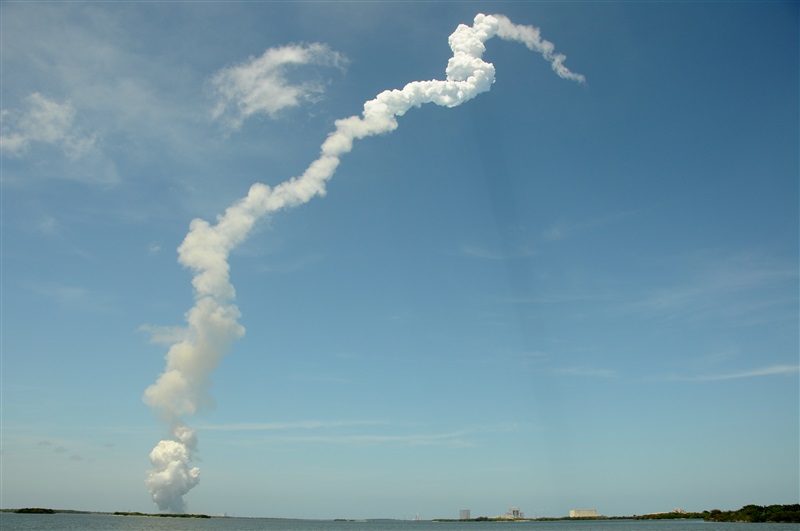
A trail, a light spot, and a memory of the sound so strong you could feel it with your whole body. I can't describe it. That alone is enough of the impression to go and experience it. That, and a sudden change of scale from everyday's to space. Here is how it works.
Liftoff. Through the first 40 seconds you keep pushing your camera's shutter continuously, bracketing like crazy since there was no way to predict the right parameters beforehand and there is no time to check them now. You just hope some of the pictures will come out right, making dozens and hundreds of exposures. All that time Atlantis is pretty much nearby. But the pace of the events quickens soon.
100 seconds. Suddenly, Space Shuttle is three times farther than it was before, and 200 mm lens becomes too weak to capture any interesting detail.
Three minutes. The little star in the sky is 50 miles away now; the SRBs have already separated and are falling from the stratosphere. You make the last panorama and pack the camera since there is really nothing new left to be seen here.
The next five minutes are spent on walking through a 500 yards distance to your bus. In that time, Shuttle reaches the speed of 4.8 miles per second and enters the orbit somewhere over the Atlantic ocean.
Then for another 40 minutes your bus is trying to get out of the congestion and finally makes it to the road to the Kennedy Space Center. Meanwhile, Space Shuttle has circumnavigated half the planet and is somewhere almost beneath your feet, near India.
"Well", some can say. "It's all very cool and so on, but was it really worth flying to Florida? After all, people who live there see rocket launches many times a year. What's so special about it?"
Really, why?
Since the late 1950s, over 250 space launch vehicles have been developed in more than a dozen of countries. Approximately half of them still fly today.
The Earth-to-low-orbit payload of those rockets varies between 0.1 and 30 tonness. The demand for satellites in that range comes from numerous business, military, scientific organizations and is sufficiently strong to support the continuous operation of broad spectra of vehicles, some for nearly 50 years now.
Above 30 tonness, there is a gap. The next “capability island” is around 100 tonness. Through the Earth history, there were only four vehicles built in that class. Each was a super-rocket. Each was at least 2-3 times heavier and more powerful than any of the other flying space machines.
The first of them was American Saturn V booster developed for Apollo lunar flights in early 60s. Its ability to bring over 120 tonness (260,000 pounds) to low Earth orbit is still unsurpassed by any vehicle as of today. Its last flight was in 1973.
The next one was Soviet N1 rocket with 75 tonness capability built secretly for a manned flight to the Moon. Plagued with numerous design, political and process flaws, it made four test flights between 1969 and 1972, all ending up with disasters. Doomed nearly from the beginning, it was finally cancelled in 1974.
The third one is the Space Shuttle based on mid-70s technologies, making the first flight in 1981 and coming to an end in 2010. Strictly speaking, it brings only 24 tonness of useful payload to the orbit. But that does not account for 70-80 tonness of the “dead weight” of the Shuttle Orbiter that returns to Earth each time. Partially as a result of that design, Space Shuttle came as a tremendously complex and expensive system which had to be heavily subsidized to stay competitive.
The last one was Soviet Energia-Buran shuttle with 100 tonness payload capability. In many aspects technologically more advanced than Space Shuttle, it made two flights in the late 1980s and came to an end with the collapse of the Soviet Union, literally buried under the debris of country's downfall.
So, of those four rockets, three do not fly anymore and the fourth one is about to become history this year. Why?
At the first glance, the answer is simple: there is no demand for such heavy payloads. Nobody needs 220 thousand pounds on the Earth orbit in one piece today, especially with recent advances in microelectronics. But this answer is shallow and therefore incomplete. These rockets were flying in the past. There was something that justified their existence some time ago that does not tick today. What was that? What were they built for?
Two of them were created to fly a man to the Moon and back. As low orbit transportation vehicles, they are too powerful. Their key advantage was in ability to deliver large cargos to the Moon. But the lunar program ended in 1970s. We do not fly there anymore. And it’s not about to change in the next 15 years unless maybe China decides to go really crazy about that.
Two other vehicles in that class were shuttles [American and Soviet]. By design, any Shuttle is disadvantageous in delivering payloads to the Earth orbit in comparison to the “traditional” rockets. It was expected to have an upper hand in different things, the most important of them being the ability to carry large goods back to Earth from space. Effectively, it is a ferry. As any ferry, it becomes economically feasible only when both sides of the river are populated and there is a lot of traffic between them. The environment where the downsides of the Space Shuttle design would’ve been compensated by its unique strengths was low Earth orbit becoming a densely populated “suburb”.
This did not happen either.
So, all these rockets including Space Shuttle were built for a different future. For a future that did not come. A future of regular lunar flights and of turning Earth orbit into a city. None of that became the reality. We've exchanged it for something else: virtual reality and real estate speculations, cool night clubs and globalized economy. Is this future worse? Most likely not. It's just different, that's it.
That’s why I wanted to see the Space Shuttle launch. Not just another rocket. But the flying relic of those days when serious people, not only kids, were seriously dreaming about space exploration.
But this all is history now. History that did not happen to us.
Appendix
1. All photos from the trip, with no comments though.
2. Details and description of STS-132 flight.
3. Excellent NASA's video of Shuttle launch: http://www.youtube.com/watch?v=E5nxN0ooD5M
4. NASA's video of Atlantis landing: http://www.youtube.com/watch?v=4dPbK8ZElZY (longer version: http://www.youtube.com/watch?v=vmDYSqjodEQ).
5. Space Shuttle launch from inside the Orbiter: http://www.youtube.com/watch?v=iwfsFtpACFw. The engines start at 03:30 and shut down at 10:18. Note the sound, especially at the first two minutes of the flight.
6. Separated fuel tank flying solo: http://www.youtube.com/watch?v=LAjfLAd3yl8
7. Time lapse of Dawn module (the primary Atlantis payload) docking to the ISS: http://www.youtube.com/watch?v=WYaujt2jZ7g
8. Atlantis in the orbit flips to be inspected from the Space Station for possible damage: http://www.youtube.com/watch?v=Co6mzeL23dg. Very impressive.
9. Time-lapse video of Space Shuttle launch preparation: http://gizmodo.com/5544749/stellar-dslr-time-lapse-of-a-space-shuttle-launch (this is a different flight though, the STS-131).